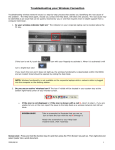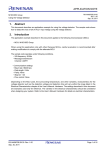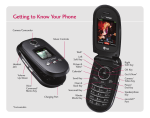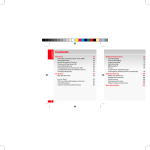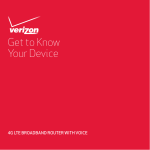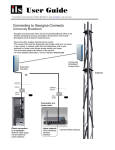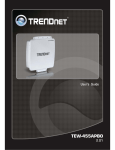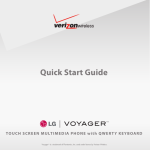Download here - Vermont Telecommunications Authority
Transcript
Vermont Telecommunications Authority Projects -‐ CoverageCo Network Frequently Asked Questions Q. What cell phone carriers use CoverageCo and how does the network function? CoverageCo supports roaming with Sprint, Verizon Wireless, T-‐Mobile USA, and Viaero Wireless, as well as Canadian carriers Rogers, Bell Canada, and Telus. Through standard commercial roaming agreements, customers can access the CovCo network using their existing phones and plans. (Please note that some carriers charge extra for roaming, and some plans do not allow roaming (see below related to pre-‐paid plans.) Individual phones have to be set for roaming in order to access the network. CoverageCo is working to expand the list of carriers by discussing roaming agreements with any GSM or CDMA provider. This cell service is targeted along roadway corridors and a few town centers. Q. Do phones that are pre-‐paid work on the CoverageCo network? Different carriers have different policies. Sprint – Sprint prepaid does not support roaming, but post-‐paid plans do. T-‐Mobile -‐ Pre-‐paid phones can be used on the network. Verizon Wireless – Supports prepaid for all but one plan. (Exception is their “Quick Access” broadband product. For prepaid customers, a “two-‐step” dialing process is required to access the service while roaming. (Customers who need assistance should be referred to Verizon Wireless Customer Service.) Q. How does roaming on CoverageCo work? The roaming function must be turned on through the cell phone itself. Once roaming is turned on, the process of using CoverageCo's network should be quite seamless. The Basics of Roaming If in any particular location, a cell phone is not getting a signal from the customer’s own carrier, then it may look for a signal from an available roaming carrier. When the cell phone "finds" the CoverageCo network, it will "register" automatically. Activating Roaming on a Cell Phone Each phone is different so although there is general information below, people may need to check their user’s manual, call tech support for the phone manufacturer, or contact their cellular carrier’s customer service. On some Sprint and Verizon phones, the customer will need to manually update their PRL (this varies by type of phone). 1 Verizon Wireless Customers • 4G phones from Verizon should update PRL automatically. • On 2G/3G phones, the update is not automatic. The first step is to try *228 to see if that updates the PRL for them. If that doesn't work to enable roaming, here are two websites with information: http://www.verizonwireless.com/support/faqs/WirelessService/faq_prl_preferred_roaming_list_update.html http://www.verizonwireless.com/b2c/howTo/prlHowTo.jsp Sprint Customers • Sprint initiates mass updates via a network push. • All phones should update the PRL automatically. • If that doesn’t work, Sprint customers should access the “Update PRL” function on their phone: on Android phones, go to Settings > More > System Update > Update PRL. For other types of phones, something similar should work. • Pre-‐paid phones do not have access to roaming so will not work on the CovCo network. • If more information is needed, recommend contacting Sprint Customer Care for support. Q. What does it cost to roam on CoverageCo? Roaming charges to subscribers are determined by their own carriers, not CoverageCo. Many carriers offer packages that include roaming. Q. What are the capabilities of the CoverageCo network? The network supports voice, text, and 2G data. Note -‐ Verizon customers are not yet able to receive 2G data service while roaming on CoverageCo. Q. Will the CoverageCo network support Internet browsing? CoverageCo’s network currently supports 2G-‐level service for now because it is the most common service for roaming. Internet browsing is possible, but it is not at broadband speeds. Technology is constantly changing and this network has been deployed with the capability to provide 4G service in the future. Q. Will I be able to call 911? Yes. Cell phone users within the CoverageCo network will be able to dial 911 from their cell phone for assistance no matter what carrier they use. Having access to 911 where there was previously no service at all is an important asset for residents and visitors alike. Q. What areas now have coverage? Updated information is available on the CoverageCo page on the VTA website: www.telecomvt.org/Cell_Service_CoverageCo.php Q. Where will expansion take place? You can find a map on www.telecomvt.org/Cell_Service_CoverageCo.php. Q. Will CoverageCo be building cell towers? No. CoverageCo is using small, low power micro-‐cell equipment mounted onto utility poles or other structures that already exist. Sites will be approximately one per mile along a coverage corridor. 2 Q. The sites are not as far away as tower equipment. Is the broadcast energy a problem? CoverageCo’s sites are low-‐powered and send out a signal that is a small fraction of a traditional cellular base station. Our base station transmits about the same amount of energy as a hand-‐held satellite phone. Q. How is CoverageCo different than traditional cellular services? CoverageCo does not sell retail cellular service directly to consumers. It is a wholesale business, so CoverageCo’s “customers” are the existing cellular carriers. Our network is technology and host-‐ neutral, which means it supports both of the two major technology families in use today, GSM and CDMA. This includes most major U.S. cellular carriers plus Canadian carriers. CoverageCo offers access to any carrier on its network that enters into an industry-‐standard roaming agreement. Q. Who makes the equipment that CoverageCo is using? The cell site radio equipment is manufactured by Vanu, Inc., a U.S. company based in Cambridge, Massachusetts. Q. What frequency does CoverageCo use? CoverageCo uses the 1900MHz band. That band is best suited to support both CDMA and GSM technologies and is supported by most phones. Q. I don’t have coverage where I live. How can I get coverage added? The Vermont Telecommunications Authority has developed a list of Target Corridors that include state and federal highways, plus a few well-‐traveled town roads where no carrier provides service, or where there are significant drop zones. These Target Corridors are the first priority for expansion coverage. You can provide input on areas that CoverageCo may consider for future coverage, by emailing specific locations where you would like to see additional service. The information will be compiled. This is simply a method for gathering information; replies are not possible. The email address is: roaming (at) coverageco.com. (Insert the @ symbol instead of "at") Q. Will this generate jobs in Vermont? CoverageCo is working with Vermont-‐based companies and contractors as much as possible. Q. Does CoverageCo offer service in other states? Vermont is the first area to be covered by the CoverageCo network. CoverageCo has received many requests for expansion in other states, but the first priority is to complete the Vermont build. Q. Where is CoverageCo located? CoverageCo is a US company with a legal office in Massachusetts. Our main office is in Leesburg, Virginia. 3




